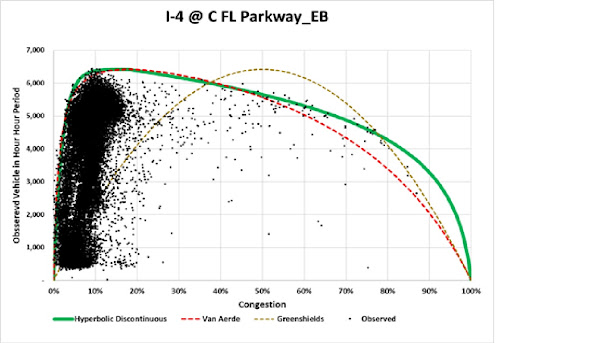Everybody’s Got A Laughing Place
Everybody's
got a laughin' place,
A laughin' place, to go ho-ho!
Take a frown, turn it upside-down
And you'll find yours I know ho-ho!
But nobody
needs a Laffer Curve!
The Laffer Curve attempts to explain the revenue from an
income tax with the rate of that income tax. It does so by assuming that this curve
can be explained by a parabola. IMHO that is why there is a problem. It assumes
that the sweet spot, maximum, is where the first derivative of the parabola is
zero. IMHO, the curve should NOT be a single parabola but instead should
be two intersecting hyperbolas. That is why there is a problem. A parabola requires
that for incomes below a zero tax rate, the tax revenue be negative, and the income
be imaginary, and at tax rates more than 100% the revenue be negative, and the
income be imaginary. A hyperbola approaches
zero revenue, but never becomes zero or negative, and thus the income never becomes imaginary.
A single parabola can look like two intersecting hyperbolas,
but these looks can be deceiving. This behavior is better explained as the
lower portion of two intersecting hyperbolas. These hyperbolas are in fact
inverses of each other and the point of intersection is also defined. The tax
rate should be 16.7% (1/6) of total income. This is the median tax rate, NOT the
highest tax rate. If the median is 16.7%, and the lowest effective tax rate is
0%, then the highest tax rate in a normal distribution should be 33.4%. This
is the effective rate, not the marginal rate. The effective tax rate is like speed;
the marginal tax rate is like acceleration. They are NOT the same and should not
be confused with each other. The marginal rate in tax tables depends on the number
of equal tax brackets. The marginal tax rate is the percentage of the maximum tax rate which applies. The effective tax rate is the marginal rate multiplied by that maximum rate. The tax rates should change from the lowest effective
rate of 0% to the highest effective tax rate of 33.4% and the lowest income in the
highest bracket should be close to the normal maximum income. If the median household income is
$74,580, in 2022 US dollars as reported by
the US Census, then the normal maximum income should be twice that, $149,160 in 2023
USD income. According to the U.S. Census Bureau, the mean household income in
the United States in 2022 was $105,555. If income was normally distributed, and the median is 50%
then the maximum should be twice the median in a normal distribution . To still
be normal if skewed, the highest income should not exceed $233,063, 2/ln(2) or ~π
Times the Median Income.. The mean income should ideally be
half of the highest income. The highest income tax bracket for married filing jointly
in the 2023‑24 IRS tax code begins at $693,750
and there are 7 brackets. The tax brackets using this, as well as the other
highest incomes, and the 7 tax brackets are shown in the table below.
The tax brackets are only a linear approximation of what is a
non-linear function. The Census mean
income occurs in the 3rd of the 7 brackets in the current IRS tables, but these
tables have unequal income brackets. If the income brackets are equalized, but the
highest Tax Code income is retained, then the Census mean income occurs in
the 2nd of the 7 brackets . If the highest income is π
times the Census median income, then the Census mean income occurs as it should
in the 4th, middle, of the 7 income brackets.
This sounds counter-intuitive, but it is mathematically consistent.
Most of the tax revenue comes from the lowest tax brackets. This is because while
the rate per taxpayer is low, there are many more taxpayers in these brackets,
so that the total revenue from these brackets is very high. The fixation on the
rates paid by the few taxpayers in the highest brackets instead of the revenue
from the majority of taxpayers in the lowest brackets has been distorting public policy. By confusing
marginal (second derivative) and effective (first derivative) tax rates, by having
unequal tax brackets, and by using the Laffer Curve, this is inconsistent with
other observations, for example observations of traffic in Florida. Those observations
of traffic also suggest that the majority of observations occur before the highest
volume. Those observations do NOT support
a regular ( such as the one proposed by Greenshields) or irregular (highly
sewed such as the one proposed by Van Aerde) parabola, but instead intersecting
hyperbolas where the intersection occurs
at 1/6th of the variance, range of congestion ( similar to tax rates
in the Laffer Curve.)
Those who don’t learn from history are doomed to repeat it.
Those who don’t know math are doomed to be conned.
References
Greenshields, B. (1935). A study of traffic
capacity. Highway Research Record, (pp. 448-477). Washington, DC.
Van Aerde, M. (1995). A single regime
speed-flow-density relationship for freeways and arterials. Washington D.
C.,: Presented at the 74th TRB Annual Meeting,.


No comments:
Post a Comment